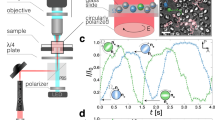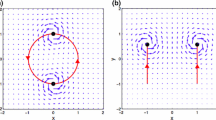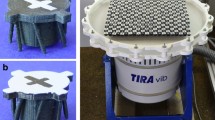Abstract
A “circular orbital forcing” makes a chosen point on a rigid body follow a circular motion while the body spins freely around that point. We investigate this problem for the planar motion of a body subject to dry friction. We focus on the effect called reverse rotation (RR), where spinning and orbital rotations are antiparallel. Similar reverse dynamics include the rotations of Venus and Uranus, journal machinery bearings, tissue production reactors, and chiral active particles. Due to dissipation, RRs are possible only as a transient. Here, the transient or flip time \(t_\text {f}\) depends on the circular driving frequency \(\omega \), unlike the viscous case previously studied. We find \(t_\text {f}\sim \omega ^{\gamma -1}\mu ^{-\gamma /2}\), where \(\mu \) is the friction coefficient and \(\gamma =0\) (\(\gamma =2\)) for low (high) \(\omega \). Whether RRs really occur depends on the initial conditions as well as on \(\mu \) and H, a geometrical parameter. The critical \(H_\text {c}(\mu )\) where RRs become possible follows a q-exponential with \(q\simeq 1.9\), a more restrictive RR scenario than in the wet case. We use animations to visualize the different dynamical regimes that emerge from the highly nonlinear dissipation mechanism of dry friction. Our results are valid across multiple investigated rigid body shapes.










Similar content being viewed by others
Data availability
The authors declare that most numerical data supporting the findings of this study are available within the article and its supplementary information files in the form of plots and movies. Source numerical data for plots and movies are also available from the corresponding author upon request.
References
Correia, A.C., Laskar, J.: The four final rotation states of venus. Nature 411, 767 (2001)
Correia, A.C., Laskar, J., de Surgy, O.N.: Long-term evolution of the spin of Venus: I. Theory. Icarus 163, 1 (2003)
Cameron, A.: Cosmological considerations regarding Uranus. Icarus 24, 280 (1975)
Berger, A., Yin, Q.: Astronomical theory and orbital forcing. In: The Sage Handbook of Environmental Change, vol. 1, pp. 405–425. Sage, London (2012)
Le Bars, M., Lacaze, L., Le Dizes, S., Le Gal, P., Rieutord, M.: Tidal instability in stellar and planetary binary systems. Phys. Earth Planet. Inter. 178, 48 (2010)
Seddon, J.R.T., Mullin, T.: Reverse rotation of a cylinder near a wall. Phys. Fluids (1994-present) 18, 041703 (2006). https://doi.org/10.1063/1.2195329
Sun, C., Mullin, T., Van Wijngaarden, L., Lohse, D.: Drag and lift forces on a counter-rotating cylinder in rotating flow. J. Fluid Mech. 664, 150 (2010)
Merlen, A., Frankiewicz, C.: Cylinder rolling on a wall at low Reynolds numbers. J. Fluid Mech. 685, 461 (2011). https://doi.org/10.1017/jfm.2011.331
Yoshida, K., Sato, K.: Characterization of reverse rotation in chaotic response of mechanical pendulum. Int. J. Non-linear Mech. 33, 819 (1998). https://doi.org/10.1016/S0020-7462(97)00053-X
De Camillo, S., Brockwell, K., Dmochowski, W.: Test results comparing the effect of reverse rotation on offset pivot journal bearing pad temperatures. Tribol. Trans. 49, 305 (2006). https://doi.org/10.1080/05698190600678622
Bechinger, C., Di Leonardo, R., Löwen, H., Reichhardt, C., Volpe, G., Volpe, G.: Active particles in complex and crowded environments. Rev. Mod. Phys. 88, 045006 (2016)
Cummings, L.J., Waters, S.L.: Tissue growth in a rotating bioreactor. Part II: Fluid flow and nutrient transport problems. Math. Med. Biol. J. IMA 24, 169 (2007). https://doi.org/10.1093/imammb/dql024
Cummings, L.J., Sawyer, N.B.E., Morgan, S.P., Rose, F., Waters, S.L.: Tracking large solid constructs suspended in a rotating bioreactor: a combined experimental and theoretical study. Biotechnol. Bioeng. 104, 1224 (2009). https://doi.org/10.1002/bit.22490
de Castro, P., Parisio, F.: Role of viscous friction in the reverse rotation of a disk. Phys. Rev. E 90, 013201 (2014)
Parisio, F.: Reverse rotations in the circularly driven motion of a rigid body. Phys. Rev. E 78, 055601 (R) (2008). https://doi.org/10.1103/PhysRevE.78.055601
Mizue, M., Naoya, J., Koichi, I., Hiroyuki, Y.: Effects of orbital motion on the boundary layer flow on a spinning disk. Open J. Fluid Dyn. 2012,(2012)
Olsson, H., Åström, K.J., De Wit, C.C., Gäfvert, M., Lischinsky, P.: Friction models and friction compensation. Eur. J. Control 4, 176 (1998)
Shaw, S.: On the dynamic response of a system with dry friction. J. Sound Vib. 108, 305 (1986)
Sumbatov, A.: On equilibrium of the stand of a physical pendulum on a horizontal plane with dry friction. Int. J. Non-linear Mech. 126, 103571 (2020)
Farkas, Z., Bartels, G., Unger, T., Wolf, D.E.: Frictional coupling between sliding and spinning motion. Phys. Rev. Lett. 90, 248302 (2003). https://doi.org/10.1103/PhysRevLett.90.248302
Melo, P.S.d.C.: Efeitos de atrito na rotação reversa de corpos rígidos circularmente forçados. Master’s thesis, Universidade Federal de Pernambuco (2014)
Zhuravlev, V.: The model of dry friction in the problem of the rolling of rigid bodies. J. Appl. Math. Mech. 62, 705 (1998)
Baker, G.L., Blackburn, J.A., Krane, K.S.: The pendulum: a case study in physics. Phys. Today 59, 52 (2006). https://doi.org/10.1063/1.2337835
Ott, E.: Chaos in Dynamical Systems. Cambridge University Press, Cambridge (2002)
Lima, T.A., Rodríguez-Pérez, S., de Aguiar, F.: Ergodicity and quantum correlations in irrational triangular billiards. Phys. Rev. E 87, 062902 (2013)
Lima, T.A., de Aguiar, F.: Classical billiards and quantum fluids. Phys. Rev. E 91, 012923 (2015)
Villa-Torrealba, A., Chávez-Raby, C., de Castro, P., Soto, R.: Run-and-tumble bacteria slowly approaching the diffusive regime. Phys. Rev. E 101, 062607 (2020)
Kümmel, F., ten Hagen, B., Wittkowski, R., Buttinoni, I., Eichhorn, R., Volpe, G., Löwen, H., Bechinger, C.: Circular motion of asymmetric self-propelling particles. Phys. Rev. Lett. 110, 198302 (2013)
Levis, D., Liebchen, B.: Simultaneous phase separation and pattern formation in chiral active mixtures. Phys. Rev. E 100, 012406 (2019)
de Castro, P., Sollich, P.: Phase separation dynamics of polydisperse colloids: a mean-field lattice-gas theory. Phys. Chem. Chem. Phys. 19, 22509 (2017). https://doi.org/10.1039/C7CP04062H
de Castro, P., Sollich, P.: Critical phase behavior in multi-component fluid mixtures: complete scaling analysis. J. Chem. Phys. 149, 204902 (2018). https://doi.org/10.1063/1.5058719
de Castro, P.: Phase separation of polydisperse fluids. Ph.D. thesis, King’s College London (2019)
de Castro, P., Sollich, P.: Phase separation of mixtures after a second quench: composition heterogeneities. Soft Matter 15, 9287 (2019)
de Castro, P., Diles, S., Soto, R., Sollich, P.: Active mixtures in a narrow channel: motility diversity changes cluster sizes. Soft Matter 17, 2050 (2020)
Acknowledgements
This research is supported by the Millennium Nucleus Physics of Active Matter of ANID (Chile) and by CNPq, CAPES and FACEPE (Brazil). We thank Paulo C. Godolphim for a critical reading of the manuscript.
Author information
Authors and Affiliations
Corresponding author
Ethics declarations
Conflict of interest
The authors declare that they have no conflict to interest.
Additional information
Publisher's Note
Springer Nature remains neutral with regard to jurisdictional claims in published maps and institutional affiliations.
Pablo de Castro: Performed at Departamento de Física, FCFM, Universidad de Chile.
Supplementary Information
Below is the link to the electronic supplementary material.
Supplementary material 1 (mp4 1378 KB)
Supplementary material 2 (mp4 1617 KB)
Appendices
Appendix A: Derivation of the rod-mass equation of motion
Here we provide additional details for the derivation of equation of motion (2) for the rod-mass system under circular driving and dry friction. As discussed in Sect. 2, Newton’s second law for rotation is
where we can use Newton’s second law for translation \(m\ddot{{\varvec{r}}}={\varvec{F}}_\text {c}+{\varvec{F}}_\text {dry}\) to eliminate \({\varvec{F}}_\text {c}\). Because of the rigid-body constraint \({\varvec{r}}+{\varvec{l}}={\varvec{d}}\), where \({{\varvec{r}}=x\,{\hat{x}}+y\,{\hat{y}}}\) and \({{\varvec{l}}=l(\cos \phi \,{\hat{x}}+\sin \phi \,{\hat{y}})}\), we have \({x=d\cos (\omega t)-l\cos \phi }\) and \({y=d\sin (\omega t)-l\sin \phi }\). As the whole mass of the rigid body is pointlike, its moment of inertia with respect to a vertical axis of rotation passing through the CM is \({I_\text {CM}=0}\). (With respect to point P, the parallel axis theorem gives \({I_P=ml^2+I_\text {CM}=ml^2}\).) Since thus \({\varvec{L}}=m{\varvec{r}}\times \dot{{\varvec{r}}}\), we have \(\dot{{\varvec{L}}}=m\dot{{\varvec{r}}}\times \dot{{\varvec{r}}}+m{\varvec{r}}\times \ddot{{\varvec{r}}}=m{\varvec{r}}\times \ddot{{\varvec{r}}}.\) We can now write the dry friction force as
Proceeding similarly for \(\ddot{{\varvec{r}}}\) and inserting everything into the rotational second law, we obtain Eq. (2), where the definition \(H\equiv l/d\) eliminates l.
Appendix B: An alternative look at q-exponentials
In this appendix, we provide a derivation of q-exponentials as objects which are suited to fit monotonous functions.
Suppose one intends to approximate some monotonous function, knowing its value \(f(0) \ne 0\) and its derivative \(f'(0)\) at \(x=0\). For definiteness, we consider decreasing functions, as those depicted in Fig. 7. In this poor-information scenario, the best thing one can do to extrapolate the values assumed by f(x) for \(x \ne 0\) is to write
A straight line is a rough approximation to an arbitrary monotonous function. As an extra ingredient, consider that some other piece of information is provided, e.g., the value f assumes for some other point \(x \ne 0\) or \(f''(0)\), its second derivative at \(x=0\).
Going to the second-order term in the Maclaurin series would leave us with a parabola, which is not monotonous. Let us take, instead, a seemingly circular approach, namely to estimate (also to first order) the function \(F(x)\equiv [f(x)]^Q = {\tilde{F}}(x)+O(x^2)\) and then to write \(f(x) \approx [{\tilde{F}}(x)]^{1/Q} \equiv {\tilde{f}}(x)\). First we have
with \(F(0)=[f(0)]^Q\) and \(F'(0)=Q[f(0)]^{Q-1}f'(0)\). That is,
which amounts to
corresponding to our approximation of the actual function f(x). The above expression is exactly the definition of the q-exponential:
with \(\lambda =|f'(0)|/f(0)\). Note that we only assumed that f is a steady decreasing function of x. These observations would be mere curiosity if it were not the fact that by expanding the previous expression to first order in x we get \({\tilde{f}}(x)=f(0) \, \mathrm{exp}_Q(-\lambda x)\approx f(0)+f'(0)x\), no matter the value of Q. Therefore, we obtain a first-order approximation at least as good as (B.1), with the difference that there is an adjustable parameter that can be used to improve the extrapolation, if one is given any extra information on f(x), while keeping the monotonous character of the original function.
Rights and permissions
About this article
Cite this article
de Castro, P., Lima, T.A. & Parisio, F. Spinning rigid bodies driven by orbital forcing: the role of dry friction. Nonlinear Dyn 107, 3473–3484 (2022). https://doi.org/10.1007/s11071-021-07175-8
Received:
Accepted:
Published:
Issue Date:
DOI: https://doi.org/10.1007/s11071-021-07175-8




